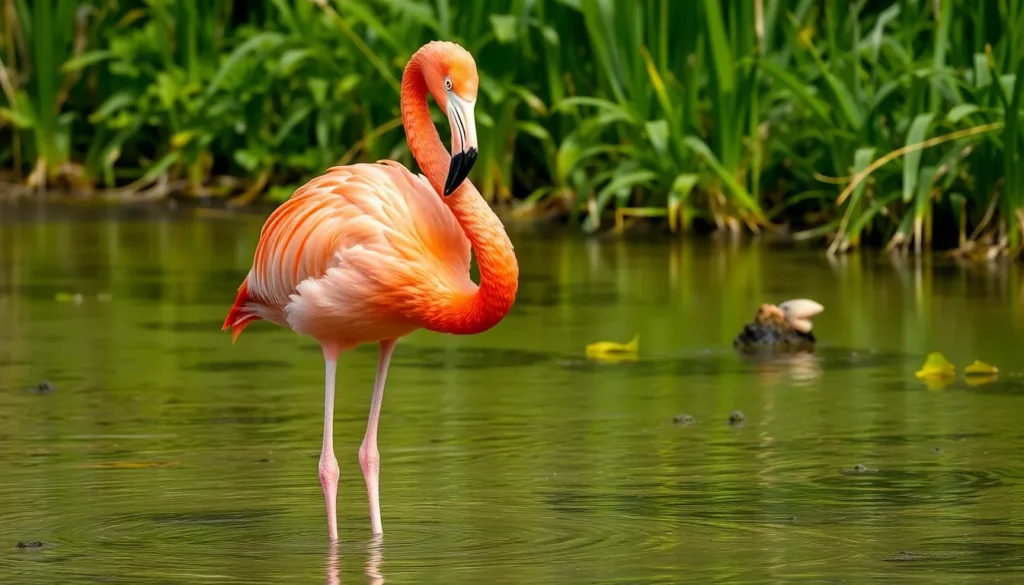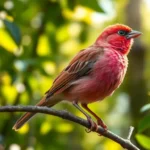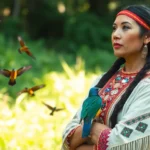We’ve all been mesmerized by the elegant pink silhouette of flamingos standing gracefully in shallow waters, but there’s so much more to these fascinating birds than meets the eye. These remarkable creatures aren’t just pretty faces – they’re evolutionary marvels with incredible adaptations that have helped them thrive in some of Earth’s most challenging environments.
From their unique feeding mechanisms to their complex social behaviors, flamingos represent one of nature’s most successful designs. We’ll explore the secrets behind their iconic pink coloration, discover how they’ve mastered the art of filter-feeding, and uncover the surprising intelligence that drives their intricate flock dynamics.
Whether you’re a bird enthusiast or simply curious about these captivating creatures, we’re about to take you on a journey through the extraordinary industry of flamingos. You’ll never look at these magnificent birds the same way again.
What Makes Flamingo Birds Unique
Flamingo birds possess extraordinary adaptations that set them apart from other avian species. These remarkable features enable flamingos to dominate aquatic environments where most birds cannot survive.
Physical Characteristics and Anatomy
Flamingo birds showcase distinctive anatomical features that maximize their survival in harsh alkaline environments. Their elongated necks contain 19 cervical vertebrae compared to the 14-15 found in most birds, allowing flamingos to reach depths of 20 inches while feeding in shallow waters.
Specialized legs demonstrate remarkable engineering with backward-bending knees that function as ankles, while their actual knees remain hidden within their body cavity. These legs can grow up to 30-50 inches in length depending on the species, with the greater flamingo reaching heights of 59 inches.
Bill structure represents their most crucial adaptation:
- Lamellae filter systems contain up to 10,000 microscopic plates
- Curved shape creates suction when inverted underwater
- Muscular tongue pumps water through filtering mechanisms
- Upper mandible remains stationary while the lower jaw moves
Webbed feet provide stability on muddy lake bottoms and enable flamingos to stir up sediment containing their preferred food sources. Dense feathers create waterproof barriers with approximately 170 feathers per square inch covering their bodies.
The Science Behind Their Pink Color
Carotenoid pigments found in flamingo diets create their iconic pink coloration through a complex metabolic process. Algae such as Dunaliella salina and crustaceans like Artemia salina contain high concentrations of beta-carotene and canthaxanthin.
The coloration process involves several biological steps:
| Process Stage | Duration | Result |
|---|---|---|
| Pigment consumption | Daily feeding | Carotenoid intake |
| Liver processing | 2-3 hours | Pigment breakdown |
| Fat storage | 24-48 hours | Cellular distribution |
| Feather deposit | 4-6 months | Color manifestation |
Flamingo birds cannot produce these pigments naturally and depend entirely on dietary sources for their vibrant appearance. Birds consuming carotenoid-rich diets display deeper pink and red hues, while those with limited access to these compounds appear pale or white.
Oil glands near their tails distribute pigmented oils throughout their feathers during preening activities. This behavior maintains color intensity and provides waterproofing essential for aquatic lifestyles.
Captive flamingos receive supplemental carotenoids including spirulina algae, carrot extracts, and synthetic additives to maintain their natural coloration. Without these supplements, zoo flamingos lose their pink color within 2-3 years.
Flamingo Bird Species Around the World
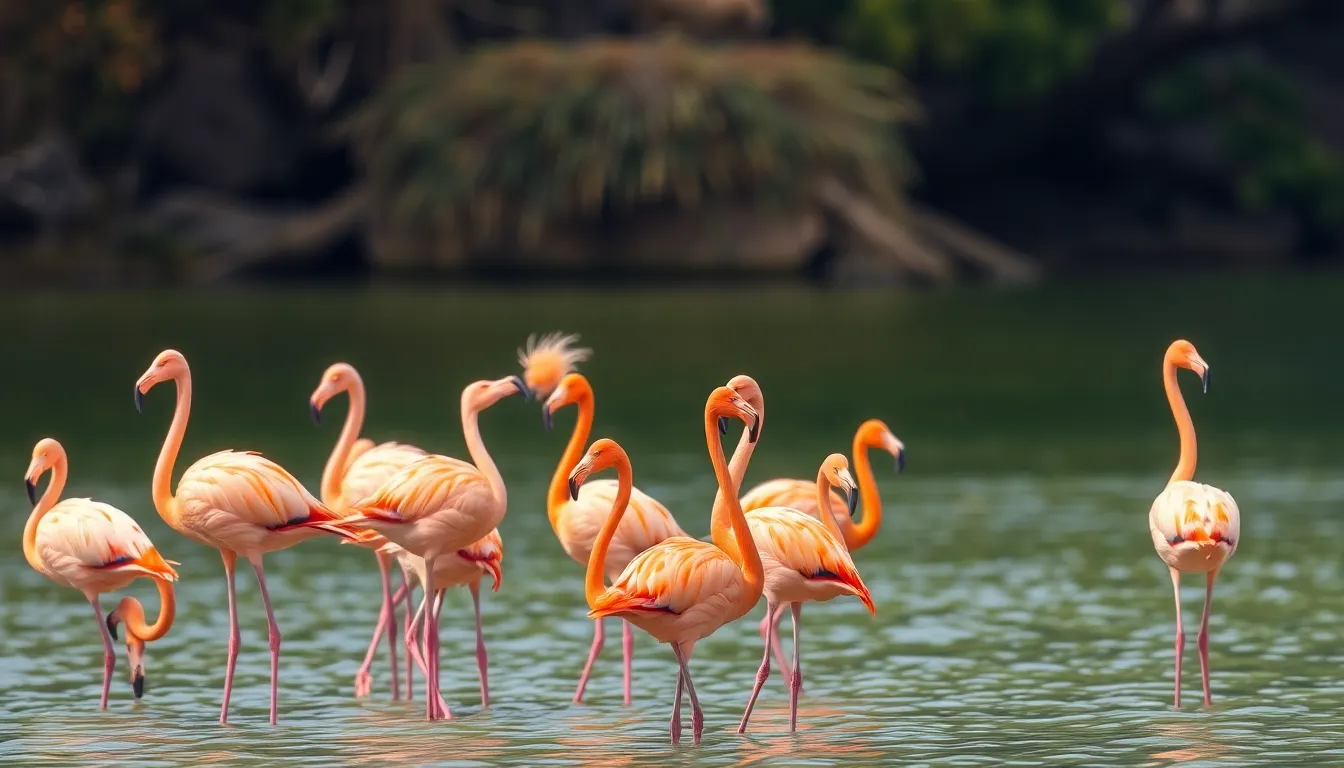
Six distinct flamingo bird species inhabit diverse regions across the globe, each adapted to exact environmental conditions and ecological niches. These remarkable birds demonstrate unique characteristics that distinguish them from one another while maintaining the iconic flamingo traits we’ve explored.
Greater Flamingo
Greater flamingos represent the largest and most widespread flamingo bird species, standing up to 59 inches tall with wingspans reaching 65 inches. These majestic birds inhabit shallow lakes, lagoons, and coastal areas across Europe, Africa, and Asia, with populations thriving in locations like the Camargue region of France, Kenya’s Lake Nakuru, and India’s Rann of Kutch.
Their distinctive pale pink plumage appears more subdued compared to other flamingo species, while their bills display characteristic black tips with pink bases. Greater flamingos filter-feed on algae, small crustaceans, and mollusks using their specialized lamellae structures. Breeding colonies can contain hundreds of thousands of individuals, creating spectacular pink carpets across suitable wetland habitats.
American Flamingo
American flamingos showcase the most vibrant pink and orange coloration among all flamingo bird species, earning them recognition as the most colorful members of their family. These birds primarily inhabit the Caribbean islands, southern Florida, and coastal areas of Central and South America, with important populations in the Bahamas, Cuba, and the Galápagos Islands.
Standing between 47-57 inches tall, American flamingos display bright coral-red plumage with distinctive black flight feathers visible during flight. Their diet consists primarily of brine shrimp, blue-green algae, and small fish, which contribute to their intense coloration through high carotenoid concentrations. Colonial nesting occurs on mudflats and small islands, where pairs construct cone-shaped mud nests for their single white eggs.
Lesser Flamingo
Lesser flamingos comprise the smallest and most many flamingo bird species, with global populations exceeding 2.5 million individuals concentrated primarily in Africa’s Rift Valley lakes. These compact birds measure 31-35 inches in height and display deep pink plumage with distinctive dark red bills and yellow eyes.
Specialized feeding adaptations allow lesser flamingos to consume microscopic blue-green algae, particularly spirulina, which thrives in highly alkaline waters with pH levels exceeding 10.5. Major breeding sites include Lake Natron in Tanzania, Lake Bogoria in Kenya, and Etosha Pan in Namibia. Their synchronized feeding behaviors create mesmerizing pink waves across lake surfaces as flocks move in coordinated formations.
Chilean Flamingo
Chilean flamingos inhabit temperate regions of South America, demonstrating remarkable adaptability to cooler climates compared to their tropical relatives. These medium-sized flamingo birds measure 43-51 inches tall and display pale pink bodies with distinctive grayish legs featuring bright pink joints and feet.
Geographic distribution spans from Peru through Chile and Argentina, with populations also found in Paraguay, Uruguay, and southern Brazil. Chilean flamingos construct their nests in high-altitude salt lakes and coastal lagoons, often at elevations exceeding 11,000 feet in the Andes Mountains. Their omnivorous diet includes small fish, aquatic insects, algae, and seeds, allowing them to exploit diverse food sources across varied habitats.
Natural Habitat and Distribution
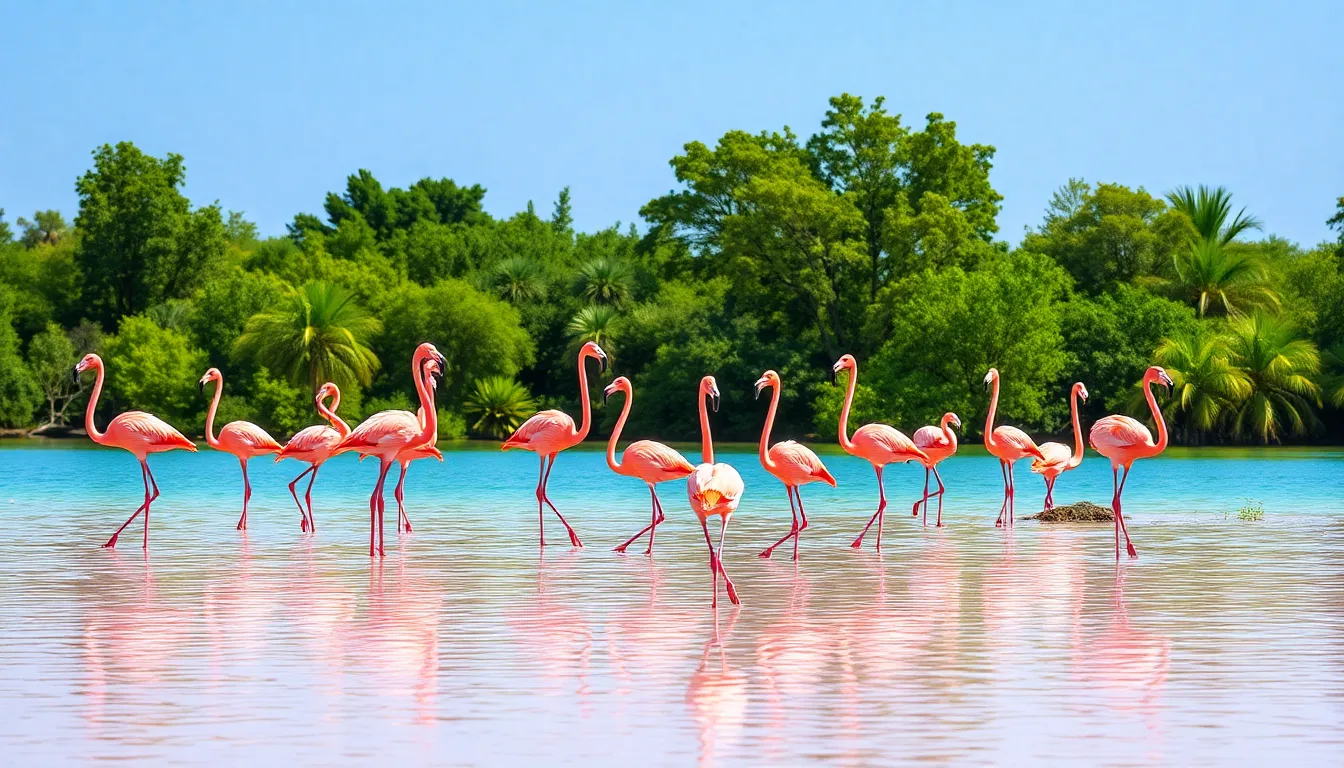
Flamingos occupy some of the planet’s most extreme aquatic environments, from hypersaline lakes to alkaline lagoons across multiple continents. These remarkable birds demonstrate exceptional adaptability to harsh conditions that few other species can tolerate.
Preferred Living Environments
Shallow alkaline lakes serve as primary habitats for most flamingo populations worldwide. These water bodies contain high concentrations of salt, sodium carbonate and other minerals that create the perfect conditions for algae and small crustacean growth. Temperature ranges in flamingo habitats typically span from 68°F to 104°F (20°C to 40°C), with some species tolerating even more extreme conditions.
Coastal lagoons provide secondary habitat options for several flamingo species, particularly in tropical and subtropical regions. Mudflats adjacent to these water bodies offer essential feeding grounds where flamingos can filter microscopic organisms from sediment. Mangrove areas support flamingo populations in the Caribbean and parts of South America, creating brackish water environments rich in nutrients.
High altitude lakes present unique challenges that certain flamingo species have mastered through evolutionary adaptation. The Andean and James’s Flamingos thrive at elevations exceeding 11,500 feet (3,500 meters) where temperatures can drop below freezing at night. Volcanic activity in these regions creates mineral rich waters that support specialized food webs.
| Habitat Type | Elevation Range | Salinity Level | Primary Species |
|---|---|---|---|
| Alkaline Lakes | 0-13,000 feet | High | Lesser, Greater |
| Coastal Lagoons | Sea level | Moderate-High | American, Chilean |
| Mudflats | Sea level | Variable | All species |
| Mountain Lakes | 9,000-15,000 feet | Extreme | Andean, James’s |
Global Migration Patterns
European and African Greater Flamingo populations undertake extensive seasonal movements spanning thousands of miles annually. These migrations follow exact flyways connecting breeding colonies in France and Spain to wintering grounds in West Africa. Weather patterns, food availability and breeding cycles trigger these massive population movements that can involve over 500,000 individuals.
Caribbean American Flamingo flocks demonstrate more localized movement patterns between island chains and coastal areas. Hurricane seasons force temporary relocations to safer inland areas, with birds returning to traditional feeding grounds once conditions stabilize. Galápagos populations remain largely resident year round due to stable equatorial conditions and abundant food sources.
African Lesser Flamingo populations exhibit the most dramatic migration behaviors among all flamingo species. Lake Nakuru and Lake Bogoria in Kenya’s Rift Valley serve as primary congregation sites, with birds moving between these locations based on algae bloom cycles. Drought conditions can trigger mass movements of over 2 million birds searching for suitable feeding areas across East Africa.
South American flamingo migrations connect breeding sites in the Andes with coastal wintering areas along the Pacific and Atlantic coasts. Chilean Flamingos travel between high altitude lakes and sea level lagoons, covering distances exceeding 400 miles (640 kilometers) during seasonal movements. Patagonian populations cross international borders regularly, moving between Argentina and Chile based on seasonal food availability.
Captive breeding programs track wild migration timing to optimize breeding success in managed populations. Research stations monitor flamingo movements using satellite telemetry and leg band identification systems across multiple countries. Climate change impacts on traditional migration routes force some populations to adapt new movement patterns and habitat preferences.
Feeding Behavior and Diet
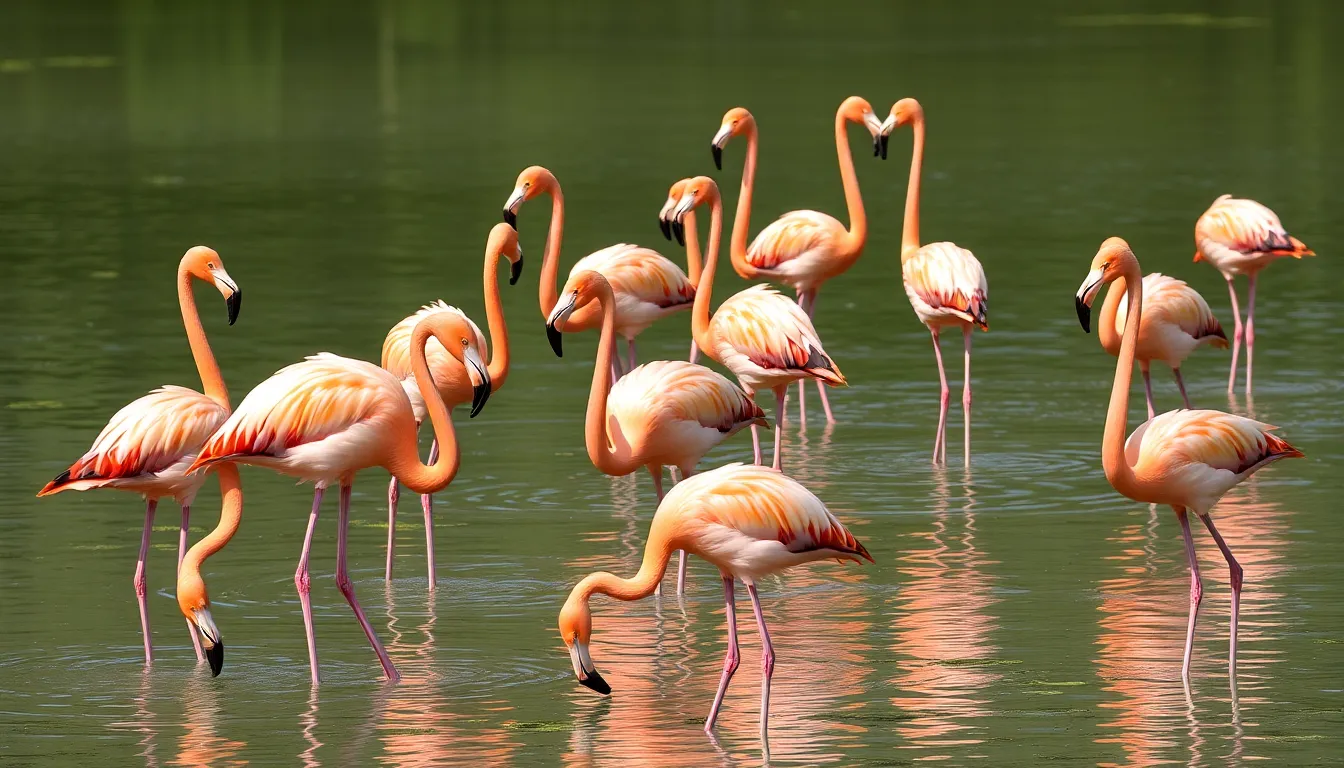
Flamingo feeding behavior represents one of nature’s most specialized filtration systems, perfectly adapted to extract nutrients from challenging aquatic environments. These remarkable birds have evolved sophisticated mechanisms to process vast quantities of water while capturing microscopic prey.
Filter Feeding Mechanism
Flamingos employ a unique inverted feeding posture that distinguishes them from all other waterbirds. Their specialized bills contain hundreds of fine lamellae (thin plates) that function as biological sieves, trapping food particles while expelling water. The tongue acts as a powerful pump, creating suction that draws water into the bill at rates exceeding 4-6 times per second.
Three distinct filtering techniques characterize flamingo feeding behavior:
- Surface skimming occurs when birds sweep their bills across water surfaces, collecting floating algae and small organisms
- Deep keeling involves submerging heads completely to access bottom sediments rich in diatoms and invertebrates
- Stamping feeding includes rhythmic foot movements that stir up sediment clouds, making buried prey accessible
The filtering process operates through lamellae spacing variations among species. Greater Flamingos possess wider spacing (approximately 0.5mm) for capturing larger crustaceans, while Lesser Flamingos feature finer lamellae (0.05mm spacing) optimized for microscopic algae filtration.
Primary Food Sources
Flamingo diets vary significantly based on species and habitat availability, though all depend on aquatic organisms rich in carotenoid pigments. Each species has evolved to exploit exact ecological niches within their shared environments.
Algae and Cyanobacteria
Lesser Flamingos consume primarily blue-green algae species including Arthrospira platensis and Dunaliella salina. These microscopic organisms comprise 95% of their diet and provide essential carotenoids for pink coloration. Greater Flamingos supplement their diets with green algae and diatoms found in shallow lake sediments.
Crustaceans and Invertebrates
American and Chilean Flamingos target small crustaceans such as brine shrimp (Artemia salina), copepods, and amphipods. These protein-rich organisms provide essential nutrients for breeding and molting cycles. Larvae of midges and other aquatic insects constitute secondary food sources during seasonal abundance periods.
Mollusks and Marine Organisms
Coastal flamingo populations consume small snails, clams, and marine worms. Caribbean American Flamingos actively hunt for gastropods in mangrove systems, while Andean Flamingos extract insect larvae from high-altitude lake sediments. Filter feeding efficiency allows consumption of up to 270 grams of food daily per individual.
Social Structure and Breeding
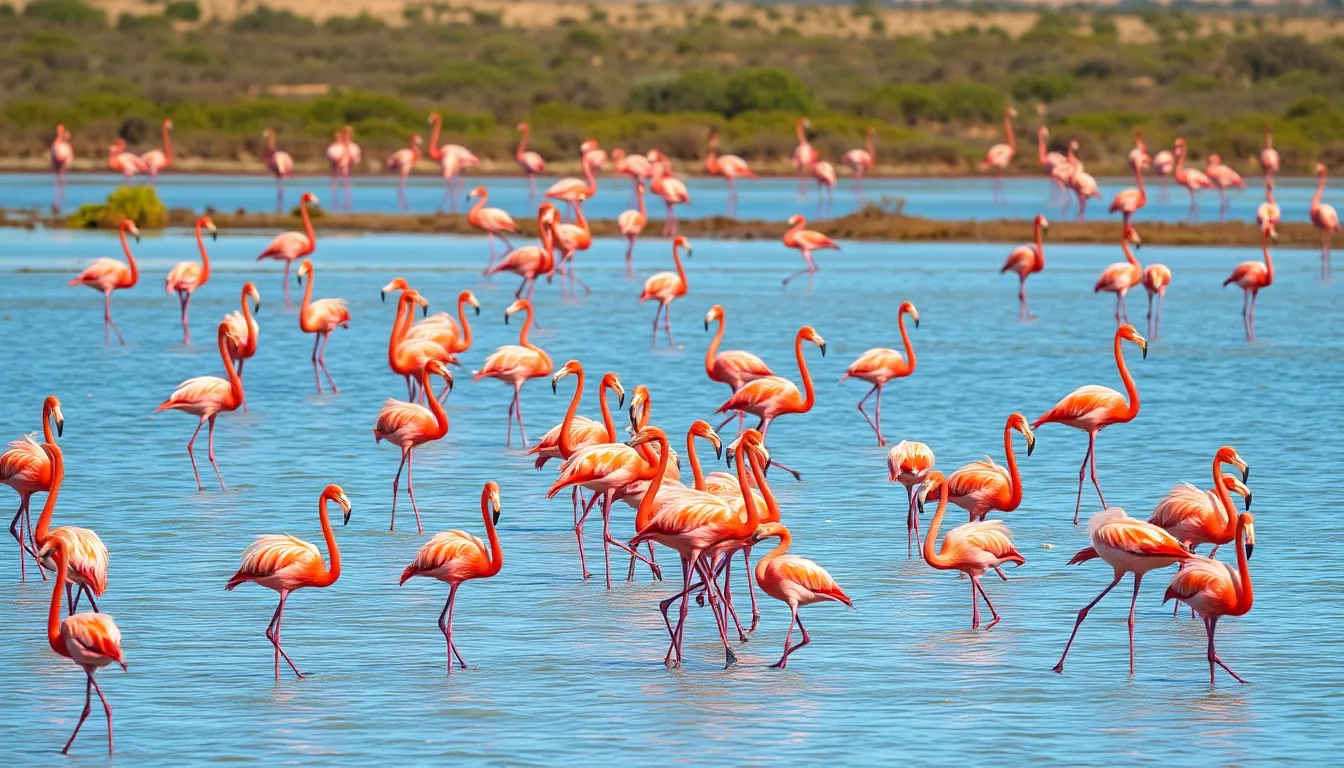
Flamingo bird colonies function as highly organized social systems where thousands of individuals coordinate their activities through complex behavioral patterns. These remarkable birds demonstrate sophisticated group dynamics that enhance survival rates and reproductive success across diverse aquatic environments.
Flocking Behavior
Flamingo flocks operate with remarkable precision through synchronized movements and collective decision making processes. Large aggregations of 10,000 to 20,000 individuals create protective environments where predator detection increases exponentially compared to smaller groups.
Group coordination emerges through visual and auditory cues that ripple across entire colonies within seconds. Individual flamingos respond to neighboring birds’ movements by adjusting their positioning and feeding patterns to maintain optimal spacing distances of 2-3 feet between individuals.
Flock Size Variations by Species:
| Species | Typical Flock Size | Peak Season Numbers |
|---|---|---|
| Greater Flamingo | 500-2,000 | 10,000+ |
| Lesser Flamingo | 1,000-5,000 | 50,000+ |
| American Flamingo | 50-500 | 2,000+ |
| Chilean Flamingo | 100-1,000 | 5,000+ |
Hierarchical structures within flamingo flocks establish feeding territories and roosting locations based on age and physical condition. Dominant individuals secure prime feeding spots in shallow alkaline waters where nutrient concentrations remain highest throughout the day.
Communication patterns include trumpeting calls, head movements, and synchronized walking displays that maintain group cohesion during feeding and migration activities. These behavioral signals enable flamingo flocks to respond collectively to environmental changes and potential threats.
Mating Rituals and Reproduction
Flamingo courtship displays rank among the most elaborate breeding ceremonies in the avian industry through synchronized group performances involving hundreds of participants. Breeding seasons typically occur during optimal environmental conditions when food resources peak and water levels stabilize in their alkaline habitats.
Group courtship rituals begin with mass displays where entire colonies perform coordinated movements including head flagging, wing saluting, and marching formations. These collective performances can last several weeks and involve 80-90% of the adult population within established breeding colonies.
Pair bonding develops through individual recognition sequences where prospective mates perform specialized greeting ceremonies and synchronized preening activities. Monogamous partnerships form for single breeding seasons, though some pairs reunite across multiple years if both individuals return to the same colony sites.
Flamingo Breeding Timeline:
| Phase | Duration | Key Activities |
|---|---|---|
| Courtship Displays | 2-4 weeks | Group ceremonies, pair bonding |
| Nest Construction | 3-7 days | Mud cone building, territory establishment |
| Incubation Period | 28-32 days | Shared parental duties, egg turning |
| Chick Rearing | 65-90 days | Feeding, protection, fledgling development |
Nest construction involves both partners building conical mud structures 12-18 inches tall that protect single eggs from flooding and temperature fluctuations. These architectural achievements require precise engineering as flamingo parents gather mud, stones, and vegetation to create stable platforms in challenging wetland environments.
Parental care extends beyond hatching as both adults produce crop milk rich in proteins and carotenoids to nourish developing chicks. Young flamingo birds remain dependent on their parents for 65-90 days while developing the specialized filtering mechanisms necessary for independent feeding in alkaline aquatic systems.
Flamingo Bird Conservation Status

Flamingo populations face mounting pressure across their global range, with several species experiencing important declines over recent decades. Conservation organizations worldwide actively monitor flamingo colonies and carry out protective measures to safeguard these remarkable birds for future generations.
Threats to Wild Populations
Habitat destruction presents the most important challenge to flamingo survival, with wetland drainage and urban development eliminating critical feeding and nesting areas. Agricultural expansion removes approximately 87% of wetland habitats in South America’s flamingo regions annually, forcing populations to compete for remaining resources.
Climate change disrupts established migration patterns and alters water levels in traditional breeding sites. Rising temperatures increase evaporation rates in shallow lakes, concentrating salt levels beyond tolerable limits for algae and crustaceans that flamingos depend upon. Droughts lasting 3-5 years reduce food availability by 60% in East African Rift Valley lakes.
Industrial pollution contaminates water sources with heavy metals and chemical runoff from mining operations. Copper and lead concentrations exceed safe levels in 43% of Chilean flamingo feeding areas, causing reproductive failure and chick mortality rates reaching 75% in affected colonies.
Human disturbance from tourism and recreational activities disrupts breeding cycles and causes nest abandonment. Photography tours and boat traffic within 200 meters of nesting colonies reduce breeding success by 35%, as stressed adults leave eggs vulnerable to predators and temperature fluctuations.
| Threat Type | Impact Percentage | Recovery Time |
|---|---|---|
| Habitat Loss | 45% population decline | 15-25 years |
| Climate Change | 30% breeding disruption | 10-20 years |
| Industrial Pollution | 25% reproductive failure | 5-15 years |
| Human Disturbance | 20% nest abandonment | 2-5 years |
Conservation Efforts and Success Stories
Protected wetland reserves spanning 2.3 million hectares provide safe havens for flamingo populations across six countries. Kenya’s Lake Nakuru National Park protects 1.2 million Lesser Flamingos during peak season, while Spain’s Doñana National Park maintains stable Greater Flamingo colonies exceeding 15,000 breeding pairs.
International cooperation through the East African Flyway Initiative coordinates conservation efforts across borders, establishing monitoring stations at 47 key sites. Research teams track individual birds using GPS transmitters, collecting data on migration routes and habitat preferences to inform protection strategies.
Captive breeding programs maintain genetic diversity and support wild population recovery through carefully managed reintroduction efforts. European zoos successfully breed 340 flamingo chicks annually, with 85% survival rates contributing to species preservation knowledge and public education programs.
Community engagement initiatives train local populations in sustainable ecotourism practices, generating income while protecting flamingo habitats. Bolivian salt flat communities earn $2.8 million annually from responsible flamingo viewing tours, creating economic incentives for conservation.
Restoration projects reconstruct degraded wetlands using native plant species and controlled water management systems. Chile’s Salar de Atacama restoration covers 450 hectares, increasing flamingo food sources by 127% over five years and supporting population growth of 23% in the region.
Pollution monitoring programs test water quality monthly at 156 flamingo sites worldwide, identifying contamination sources and implementing remediation measures. Mercury levels decreased 68% in Argentine lakes following mining regulation enforcement, resulting in improved chick survival rates.
Conclusion
Flamingos continue to captivate us with their remarkable ability to transform harsh environments into thriving habitats. These resilient birds demonstrate that nature’s most beautiful creations often emerge from the most challenging circumstances.
As we face growing environmental pressures our understanding of flamingo conservation becomes increasingly vital. Their success stories remind us that dedicated protection efforts can make a real difference for wildlife populations worldwide.
We hope this exploration has deepened your appreciation for these extraordinary birds and their complex ecosystems. Flamingos truly represent one of nature’s most perfect examples of adaptation beauty and survival working in perfect harmony.
Frequently Asked Questions
What makes flamingos pink?
Flamingos get their pink color from carotenoid pigments found in their diet. These pigments come from algae, crustaceans, and other aquatic organisms they consume. The carotenoids are metabolically processed and deposited in their feathers, skin, and beaks. Without these dietary sources, flamingos would lose their vibrant coloration and appear white or pale gray.
How many species of flamingos exist?
There are six distinct flamingo species worldwide: Greater Flamingo, American Flamingo, Lesser Flamingo, Chilean Flamingo, James’s Flamingo, and Andean Flamingo. Each species has adapted to specific environmental conditions and geographical regions, from the alkaline lakes of Africa to the coastal lagoons of the Caribbean and the high-altitude lakes of South America.
How do flamingos feed?
Flamingos use a specialized filtration system with their uniquely shaped bills. They feed upside down, using fine structures called lamellae that act as biological sieves to filter nutrients from water. They employ three main techniques: surface skimming, deep keeling, and stamping to extract algae, crustaceans, and small organisms from their aquatic environment.
Where do flamingos live naturally?
Flamingos inhabit extreme aquatic environments including hypersaline lakes, alkaline lagoons, coastal mudflats, and high-altitude lakes. They’re found across Europe, Africa, Asia, the Caribbean, and South America. These birds prefer shallow waters with high mineral content that support the growth of their primary food sources like algae and small crustaceans.
Do flamingos migrate?
Yes, many flamingo species migrate seasonally. European and African Greater Flamingos undertake extensive movements, while Caribbean American Flamingos make more localized migrations. African Lesser Flamingos show dramatic migration patterns following algae bloom cycles, and South American species move between Andean breeding sites and coastal wintering areas based on seasonal conditions.
How do flamingos breed and raise their young?
Flamingos breed in large colonies with elaborate courtship displays involving synchronized dancing and calling. They build conical mud nests and typically lay one egg. Both parents share incubation duties for about 28-32 days and care for the chick together, feeding it a nutrient-rich secretion called “crop milk” until it can filter-feed independently.
Are flamingos endangered?
Several flamingo species face population declines due to habitat destruction, climate change, pollution, and human disturbance. While not all species are critically endangered, many face significant threats. Conservation efforts include protected wetland reserves, international monitoring programs, captive breeding initiatives, and community-based ecotourism to help preserve their populations and habitats.
How social are flamingos?
Flamingos are highly social birds that live in organized colonies ranging from hundreds to millions of individuals. They exhibit synchronized movements, collective decision-making, and hierarchical structures for feeding territories. This flocking behavior enhances predator detection, improves resource allocation, and increases breeding success through coordinated group activities and mutual protection.

